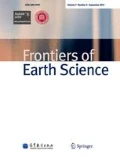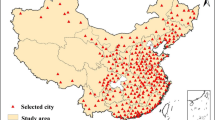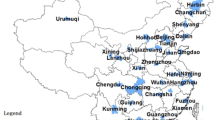Abstract
Since 2000, China’s urban land has expanded at a dramatic speed because of the country’s rapid urbanization. The country has been experiencing unbalanced development between rural and urban areas, causing serious challenges such as agricultural security and land resources waste. Effectively evaluating the driving factors of urban land growth is essential for improving efficient land use management and sustainable urban development. This study established a principal component regression model based on eight indicators to identify their influences on urban land growth in Guangzhou. The results provided a grouping analysis of the driving factors, and found that economic growth, urban population, and transportation development are the driving forces of urban land growth of Guangzhou, while the tertiary industry has an opposite effect. The findings led to further suggestions and recommendations for urban sustainable development. Hence, local governments should design relevant policies for achieving the rational development of urban land use and strategic planning on urban sustainable development.
Similar content being viewed by others
References
Achmad A, Hasyim S, Dahlan B, Aulia D N (2015). Modeling of urban growth in tsunami-prone city using logistic regression: analysis of Banda Aceh, Indonesia. Appl Geogr, 62(8): 237–246
Aljoufie M (2014). Toward integrated land use and transport planning in fast-growing cities: the case of Jeddah, Saudi Arabia. Habitat Int, 41 (1): 205–215
Bai X, Shi P, Liu Y (2014). Realizing China’s urban dream. Nature, 509 (1799): 158–160
Bao X F, Mei Z X, Liu X F (2014). Evolvement of spatial pattern of land use change intensity in Guangzhou. Journal of South China Normal University (natural science edition), 46(5): 118–125 (in Chinese)
Chen H Y, Jia B S, Lau S S Y (2008). Sustainable urban form for Chinese compact cities: challenges of a rapid urbanized economy. Habitat Int, 32(1): 28–40
Chen J F, Chang K T, Karacsonyi D, Zhang X L (2014). Comparing urban land expansion and its driving factors in Shenzhen and Dongguan, China. Habitat Int, 43(7): 61–71
Chen Y, Chen Z G, Xu G L, Tian Z Q (2016a). Built-up land efficiency in urban China: insights from the General Land Use Plan (2006–2020). Habitat Int, 51(2): 31–38
Chen Y B, Chang K T, Han F Z, Karacsonyi D, Qian Q L (2016b). Investigating urbanization and its spatial determinants in the central districts of Guangzhou, China. Habitat Int, 51(2): 59–69
Conke L S, Ferreira T L (2015). Urban metabolism: measuring the city’s contribution to sustainable development. Environ Pollut, 202(7): 146–152
Cui X Z, Wang X T (2014). Urban land use change and its effect on social metabolism: an empirical study in Shanghai. Habitat Int, 49 (10): 251–259
Cui X Z, Wang Y W, Chang Y (2012). The anthropogenic factors on urban growth: an empirical quantification in China. Advanced Materials Research, 518–523: 6042–6049
Cui Y (2007). “An analysis of drag” of land resource in China’s economic growth. Economic Theory and Economic Management, 28 (11): 32–37 (in Chinese)
Debolini M, Valette E, Francois M, Chéry J P (2015). Mapping land use competition in the rural–urban fringe and future perspectives on land policies: a case study of Meknès (Morocco). Land Use Policy, 47(9): 373–381
Fischer G, Sun L X (2001). Model based analysis of future land use development in China. Agric Ecosyst Environ, 85(1–3): 163–176
Gao J L, Wei Y D, Chen W, Chen J L (2014). Economic transition and urban land expansion in Provincial China. Habitat Int, 44(10): 461–473
Gibson C C, Ostrom E, Ahn T K (2000). The concept of scale and the human dimensions of global change: a survey. Ecol Econ, 32(2): 217–239
Gong J Z, Chen W, Liu Y S, Wang J Y (2014). The intensity change of urban development land: implications for the city master plan of Guangzhou, China. Land Use Policy, 40(9): 91–100
Gu X, Qu F T, Fu G H (2009). Comparative superiority of land use and regional industry structure adjustment. China Land Science, 23(7): 61–65 (in Chinese)
Guo L, Du S H, Xue D Y, Jiang X D (2008). Spatio-Temporal variation of landscape patterns during rapid urbanization in Guangzhou City. Acta Sci Nat Univ Pekin, 3: 115–122 (in Chinese)
Kong F H, Yin H W, Nakagoshi N, James P (2012). Simulating urban growth processes incorporating a potential model with spatial metrics. Ecol Indic, 20(9): 82–91
Li J T (2014). Annual Report on Economic Development of Guangzhou (2014). China: Social Science Academic Press
Li W L, Yan X P (2002). Study on the development of urban MTR system and land compound use—A case in Guangzhou city. Scientia Geographica Sinica, 22(1): 574–580 (in Chinese)
Li X, Chen G Z, Liu X Y, Liang X,Wang S J (2017). A new global landuse and land-cover change product at a 1-km resolution for 2010–2100 based on human-environment interactions. Ann Assoc Am Geogr, 07(5): 1040–1059
Li X Y, Fang J Y, Piao S L (2006). Urban land use development and related spatial mechanism in Shanghai region. Resources and environment in the Yangtze basin, 15(1): 34–40 (in Chinese)
Lin J, Huang B, Chen M, Huang Z (2014). Modeling urban vertical growth using cellular automata—Guangzhou as a case study. Appl Geogr, 53(9): 172–186
Liu J Y, Zhang Z X, Zhuang D F,Wang YM, ZhouWC, Zhang SW, Li R D, Jiang N, Wu S X (2003). A study on the spatial-temporal dynamic changes of land use and driving forces analyses of China in the 1990s. Geogr Res, 22(1): 1–12 (in Chinese)
Liu R, Zhu D L, Zhu Z Q, Yang W Z (2009). Analysis of the driving forces of urban sprawl in Dezhou city based on a logistic regression model. Resources Science, 31(11): 1919–1926 (in Chinese)
Liu X J, Wang M S (2016). How polycentric is urban China and why? A case study of 318 cities. Landsc Urban Plan, 151(7): 10–20
Liu X P, Liang X, Li X, Xu X C, Ou J P, Chen Y, Li S, Wang S, Pei F (2017). A future land use simulation model (FLUS) for simulating multiple land use scenarios by coupling human and natural effects. Landsc Urban Plan, 168(12): 94–116
Liu X P, Ma L, Li X, Ai B, Li S Y, He Z J (2014a). Simulating urban growth by integrating landscape expansion index (LEI) and cellular automata. Int J Geogr Inf Sci, 28(1): 148–163
Liu Y, Huang X J, Yang H, Zhong T Y (2014b). Environmental effects of land-use/cover change caused by urbanization and policies in Southwest China Karst area–A case study of Guiyang. Habitat Int, 44(10): 339–348
Liu Y L, Luo T, Liu Z Q, Kong X S, Li J W, Tan R H (2015). A comparative analysis of urban and rural construction land use change and driving forces: implications for urban–rural coordination development in Wuhan, Central China. Habitat Int, 47(6): 113–125
Liu Y S, Lu S S, Chen Y F (2013). Spatio-temporal change of urban–rural equalized development patterns in China and its driving factors. J Rural Stud, 32(10): 320–330
Long H L, Liu Y Q, Hou X G, Li T T, Li Y R (2014). Effects of land use transitions due to rapid urbanization on ecosystem services: implications for urban planning in the new developing area of China. Habitat Int, 44(10): 536–544
Ma X G,Wang AM, Yan X P (2010). A study on land use conflicts in the urban spatial reconstruction process—A case study of Guangzhou city. Human Geogr, 25(3): 72–77 (in Chinese)
Ma Y L, Xu R S (2010). Remote sensing monitoring and driving force analysis of urban expansion in Guangzhou City, China. Habitat Int, 34(2): 228–235
Meng Y, Zhang F R, Jiang G H, Chen T S (2011). The study on the relationship between economic structure and land use structure in Beijing. Areal Research and Development, 30(3): 108–111 (in Chinese)
Mertens B, Lambin E F (1997). Spatial modelling of deforestation in Southern Cameroon: spatial disaggregation of diverse deforestation processes. Appl Geogr, 17(2): 143–162
Mertens B, Lambin E F (2000). Land-cover-change trajectories in southern Cameroon. Ann Assoc Am Geogr, 90(3): 467–494
Musakwa W, Niekerk A V (2013). Implications of land use change for the sustainability of urban areas: a case study of Stellenbosch, South Africa. Cities, 32(6): 143–156
Pablo B G, Francisco A B, Montserrat G D (2015). Partial validation of cellular automata based model simulations of urban growth: an approach to assessing factor influence using spatial methods. Environ Model Softw, 69(7): 77–89
Pandey B, Seto K C (2015). Urbanization and agricultural land loss in India: comparing satellite estimates with census data. J Environ Manage, 148(15): 53–66
Pontius R G Jr, Cornell J D, Hall C A S (2001). Modeling the spatial pattern of land-use change with GEOMOD2: application and validation for Costa Rica. Agric Ecosyst Environ, 85(1–3): 191–203
Pontius R G Jr, Schneider L C (2001). Land-use change model validation by an ROC method for the Ipswich watershed, Massachusetts, USA. Agric Ecosyst Environ, 85(1–3): 239–248
Pribadi O D, Pauleit S (2015). The dynamics of peri-urban agriculture during rapid urbanization of Jabodetabek Metropolitan Area. Habitat Int, 48(11): 13–24
Serneels S, Lambin E F (2001). Proximate causes of land use change in Narok district Kenya: a spatial statistical model. Agric Ecosyst Environ, 85(1–3): 65–81
Sun J, Zhang L H, Peng C L, Peng Z R, Xu M (2012). CA-based urban land use prediction model: a case study on Orange County, Florida, U.S. J Transp Syst Eng Inf Technol, 12(6): 85–92
Tian L (2015). Land use dynamics driven by rural industrialization and land finance in the peri-urban areas of China: “The examples of Jiangyin and Shunde. Land Use Policy, 45(5): 117–127
Turner B L II, Skole D L, Sanderson S, Fischer G, Fresco L O, Leemans R (1995). Land-Use and Land-Cover Change- Science/Research Plan. Stockholm and Geneva: IGBP Report No. 35, HDP Report No. 7
Turner M G, Wear D N, Flamm R O (1996). Land ownership and landcover change in the Southern Appalachian Highlands and the Olympic Peninsula. Ecol Appl, 6(4): 1150–1172
Verburg P H, Schot P P, DijstMJ, Veldkamp A (2004). Land use change modelling: current practice and research priorities. GeoJournal, 61 (4): 309–324
Waddell P (2000). A behavioral simulation model for metropolitan policy analysis and planning: residential location and housing market components of UrbanSim. Environ Plan, 27(2): 247–263
Wang H, Zhang X L, Skitmore M (2015). Implications for sustainable land use in high-density cities: evidence from Hong Kong. Habitat Int, 50(12): 23–34
Wear D N, Bolstad P (1998). Land-use changes in Southern Appalachian Landscapes: spatial analysis and forecast evaluation. Ecosystems (N Y), 1(6): 575–594
Xiao J Y, Shen Y J, Ge J F, Tateishi R, Tang C Y, Liang Y Q, Huang Z (2006). Evaluating urban expansion and land use change in Shijiazhuang, China, by using GIS and remote sensing. Landsc Urban Plan, 75(1–2): 69–80
Xu J J, Tao W X, Bao G J, Li Z G (2006). Research of differences between areas of influencing factors of metropolitan developed land in China. Econ Geogr, 26(S1): 152–156 (in Chinese)
Xu Q, Yang R, Dong Y X, Liu Y X, Qiu L R (2016). The influence of rapid urbanization and land use changes on terrestrial carbon sources/ sinks in Guangzhou, China. Ecol Indic, 70(11): 304–316
Yang R, Liu Y S, Long H L (2015). The study on non-agricultural transformation co-evolution characteristics of “population-landindustry”: case study of the Bohai Rim in China. Geogr Res, 34(3): 475–486 (in Chinese)
Yuan L L (2005). Analyses of the evolvement and its dynamic mechanism of the spatial structure of urban land in urbanization. Geography and Geo-information Science, 21(3): 51–55 (in Chinese)
Zhang B, Pu L J, Huang X J, Zhou Q, LuMM, Li XW (2005). Land use change and driving mechanism research in city region—The Yangtze river delta as an example. Resources and Environment in the Yangtze Basin, 14(1): 28–33 (in Chinese)
Zhang X L, Wu Y Z, Shen L Y (2011). An evaluation framework for the sustainability of urban land use: a study of capital cities and municipalities in China. Habitat Int, 35(1): 141–149
Zhang Z L (2009). An analysis of driving forces of urban land expansion in Beijing. Econ Geogr, 29(7): 1182–1185 (in Chinese)
Zheng H W, Shen G Q, Wang H, Hong J K (2015). Simulating land use change in urban renewal areas: a case study in Hong Kong. Habitat Int, 46(4): 23–34
Zhou Y, Huang X J, Chen Y, Zhong T Y, Xu G L, He J L, Xu Y T, Meng H (2017). The effect of land use planning (2006–2020) on construction land growth in China. Cities, 68(8): 37–47
Zhu F K, Zhang F R, Li C, Zhu T F (2014). Functional transition of the rural settlement: analysis of land-use differentiation in a transect of Beijing, China. Habitat Int, 41(1): 262–271
Acknowledgements
This paper is funded by the National Natural Science Foundation of China (Grant Nos. 71603062 and 41401432), the Project of Philosophy and Social Sciences in Guangdong Province (GD14CGL02); the Project of Science and Technology for local universities in Guangzhou City (1201420951); Guangzhou University’s 2017 training program for young top-notch personnel (BJ201723).
Author information
Authors and Affiliations
Corresponding author
Rights and permissions
About this article
Cite this article
Cui, X., Li, S., Wang, X. et al. Driving factors of urban land growth in Guangzhou and its implications for sustainable development. Front. Earth Sci. 13, 464–477 (2019). https://doi.org/10.1007/s11707-018-0692-1
Received:
Accepted:
Published:
Issue Date:
DOI: https://doi.org/10.1007/s11707-018-0692-1




